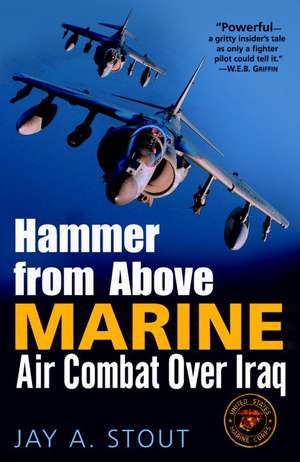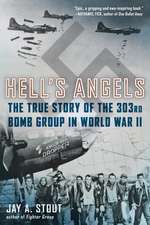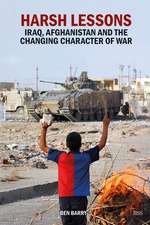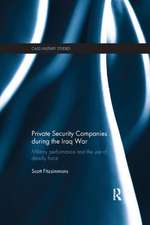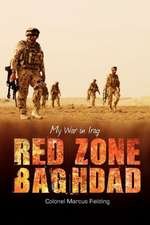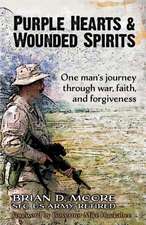Hammer from Above: Marine Air Combat Over Iraq
Autor Jay A. Stouten Limba Engleză Paperback – 30 noi 2006
As Jay Stout reveals, the air war had actually been in the planning stages ever since the victory of Operation Desert Storm, twelve years earlier. But when Operation Iraqi Freedom officially commenced on March 20, 2003, the Marine Corps entered the fight with an aviation arm at its smallest since before World War II. Still, with the motto “Speed Equals Success,” the separate air and ground units acted as a team to get the job done.
Drawing on exclusive interviews with the men and women who flew the harrowing missions, Hammer from Above reveals how pilots and their machines were tested to the limits of endurance, venturing well beyond what they were trained and designed to do. Stout takes us into the cockpits, revealing what it was like to fly these intense combat operations for up to eighteen hours at a time and to face incredible volumes of fire that literally shredded aircraft in midair during battles like that over An Nasiriyah .
With its dynamic descriptions of perilous flights and bombing runs, Hammer from Above is a worthy tribute to the men and women who flew and maintained the aircraft that so inspired their brothers in arms and terrified the enemy.
From the Hardcover edition.
Preț: 116.64 lei
Nou
Puncte Express: 175
Preț estimativ în valută:
22.32€ • 23.35$ • 18.54£
22.32€ • 23.35$ • 18.54£
Carte disponibilă
Livrare economică 13-27 martie
Preluare comenzi: 021 569.72.76
Specificații
ISBN-13: 9780891418719
ISBN-10: 0891418717
Pagini: 392
Ilustrații: 1/16 PAGE B/W INSERT
Dimensiuni: 139 x 212 x 24 mm
Greutate: 0.34 kg
Editura: Presidio Press
ISBN-10: 0891418717
Pagini: 392
Ilustrații: 1/16 PAGE B/W INSERT
Dimensiuni: 139 x 212 x 24 mm
Greutate: 0.34 kg
Editura: Presidio Press
Notă biografică
Jay A. Stout is a retired Marine fighter pilot whose twenty-year career included thirty-seven missions in Operation Desert Storm. He is the co-author of The First Hellcat Ace and the author of Hornets Over Kuwait, Fortress Ploesti: The Campaign to Destroy Hitler’s Oil, and articles for journals and newspapers nationwide. He currently works in the aviation industry for a major defense contractor.
From the Hardcover edition.
From the Hardcover edition.
Extras
Marine Aviation Primer
The Marine Corps sent many brave men into the skies over Iraq during the spring campaign of 2003. This book will describe their actions and perhaps bring more awareness to a public that for the most part is barely aware the air arm of the Marine Corps even exists. That this is so is remarkable considering the many legends who have flown in our country’s service while wearing a Marine uniform.
Ted Williams twice interrupted one of the most fantastic careers in baseball to fly and fight in both World War II and Korea. Likewise, Marine Corps pilot John Glenn flew in the same two wars and went on to become the first American to orbit the planet. Ed McMahon started adulthood as a pilot with the Marines during World War II and years later sat beside Tonight Show host Johnny Carson and entertained millions. Joe Foss, the great sportsman, governor of South Dakota, and chairman of the NRA, won the Medal of Honor while flying in World War II as a Marine Corps fighter pilot. And Gregory “Pappy” Boyington fought and drank himself into one of aviation’s most colorful and enduring legends.
Regardless of public awareness, Marine Corps aviation has been producing these types of men since 1912. It was in May of that year that First Lieutenant Alfred A. Cunningham was directed to report to the Naval Aviation Camp in Annapolis, Maryland. A few months later, on August 20, he soloed after two hours and forty minutes of flight time and became Marine Aviator Number 1.
Aviation in the Marine Corps grew slowly until the United States entered World War I in April 1917. At the time the entire aviation complement of the Marine Corps numbered only fifty-two officers and enlisted men. Just more than a year later, 758 men staffing three squadrons arrived in France on July 30, 1918. They came without their own flying machines; it wasn’t until the end of September that they received their first aircraft. Still, during the short time before the war ended in mid-November, the Marines managed to make their mark by shooting down several German aircraft. Indeed, their ferocity was such that Second Lieutenant Ralph Talbot and Gunnery Sergeant Robert Guy Robinson each earned the Medal of Honor while flying together for actions that are described in part by the following excerpt from Robinson’s citation:
. . . on October 14th, 1918, while on a raid over Pittman, Belgium, his plane and one other became detached from the formation on account of motor trouble, and were attacked by twelve enemy scouts. In the fight which ensued he behaved with conspicuous gallantry and intrepidity. After shooting down one of the enemy planes he was struck by a bullet which carried away much of his elbow and his gun jammed at the same time. He cleared the jam with one hand while his pilot maneuvered for position. With the gun cleared, he returned to the fight though his left arm was useless, and fought off the enemy scouts until he collapsed after receiving two more bullet wounds, one in the stomach and one in the thigh.
Robinson survived despite suffering multiple bullet wounds and having his arm very nearly shot off. Talbot received his medal posthumously; he was killed only a few days later in a plane crash.
Immediately following the war Marine aviation underwent a period of massive reductions, as did the air branches of all the services. By 1921 the Corps carried only forty-three pilots on its rolls. Despite the huge cutbacks that most of the world’s militaries underwent, the interwar years were a time of rapid technological development in aeronautics that saw a gradual buildup of capabilities within the Corps’s air arm. During this time the Marine Corps was the only U.S. service to put its fliers into combat. Flying and fighting throughout various Caribbean and Central American insurrections, Marine aviators experimented with tactics and techniques that would be refined and used years later. Some of these were exceedingly dangerous. During fighting in Nicaragua from January 6 to January 8, 1928, First Lieutenant Christian Schilt made ten separate sorties under enemy fire into a makeshift landing strip in Quilali to evacuate eighteen Marines who had been seriously wounded in an ambush. For his efforts, Schilt was rewarded with the Medal of Honor.
Schilt’s extraordinary mission marked the unbreakable relationship between the infantryman and the aviator that has become a pillar of the Marine Corps ethos. Simply put, the primary reason the service keeps aircraft and the men and women to fly and maintain them is to support the Marine on the ground. This is an indissoluble tenet that every Marine aviator learns from the first day he puts on a uniform. Parallel to this is the dictum that every flier is a rifleman first; he receives basic infantry skills and training before he ever approaches an aircraft. This fosters empathy and understanding between the ground and air communities and also serves a more practical purpose: It enables the aviator to more readily understand the ground commander’s intentions and requirements.
Through the 1930s the Marine air arm continued to develop and grow. It was during this time that a close relationship with the Navy became even more so. Marine squadrons saw service on aircraft carriers, and the Marine Corps became wholly and fully committed to developing a navalized air arm in terms of operations and equipment. And as doctrines and strategies were matured to address Japanese aspirations in the Pacific and Asia, more emphasis was placed on joint operations with the Navy; these joint operations were oriented toward the seizure of advance bases in the event of war. The execution of this strategy would be the centerpiece of naval operations during World War II.
By the late 1930s the U.S. military still lagged behind the other great nations in preparing for the coming cataclysm that was World War II. The situation was so abysmal that second-tier countries such as Portugal fielded larger armies than America. The Marine Corps was a reflection of this lack of readiness, particularly where its air arm was concerned. In June 1940, while France was being overrun by the Nazis, Marine aviation numbered less than nineteen hundred personnel. More than a year later the Japanese attack on Pearl Harbor caught the Corps as much by surprise as anyone else: Every airplane at the Marine airfield at Ewa was destroyed.
Farther out in the Pacific, Marine fliers made the Japanese pay more dearly for the tiny speck that was Wake Island. Although seven of its twelve aircraft were destroyed on the ground at nearly the same time as the attack on Pearl Harbor, VMF-211 continued to fight for the next several weeks. The squadron’s pilots sent the destroyer Kirasagi to the bottom and shot down seven enemy aircraft. When their last F4F Wildcat was destroyed, the twenty pilots and mechanics from the unit who hadn’t been killed or wounded climbed out of their flight gear and dropped their wrenches to fight as infantry. Those who survived the final Japanese assault spent the rest of the war as POWs.
But it was at Guadalcanal where the Marine Corps’s fliers and “wrench turners” earned a permanent place in history. When the Navy’s aircraft carriers were forced to retreat under the threat of superior Japanese forces, the aerial defense of the beleaguered Marines on the ground was left to the handful of their brothers who piloted a pitifully small and hard-worn collection of F4Fs against a seemingly unceasing stream of Japanese fighters and bombers. Living in the rot and wet and filth of the jungle, they fought alongside a hodgepodge collection of airplanes from both the Navy and the Army for several months until the island was declared secure. It was here that the Marine Corps showed the world that the Japanese Zero was far from invincible. And it was at Guadalcanal where Joe Foss equaled the twenty-six aerial victories scored by America’s greatest ace of World War I, Captain Eddie Rickenbacker.
By the end of the war the Marine Corps counted more than 125,000 men in its air arm alone—more than a sixtyfold increase in five years. These officers and enlisted men had slugged their way across the Pacific and had seen action over such legendary battlefields as Bougainville, Rabaul, Iwo Jima, Okinawa, and even Japan itself. In doing so they shot down more than twenty-three hundred enemy aircraft and produced 121 aces. Aside from killing other aircraft, perhaps their most important contribution to the war was the hard-hitting support they provided to the infantrymen on the ground. As airborne “artillery” they provided such a volume, range, and flexibility of fire that no Marine commander would ever again seriously consider a major operation without Marine airpower overhead.
Less than five years after the end of the greatest conflict in history, the Corps’s fliers were at war again. Korea saw more refinement of cooperative operations between the “ground pounder” and the pilot. When Red China surprised the world by launching a million men over the border and into the fight during October 1950, Marine aircrews surprised those same Chinese by chopping them down by the thousands. It was this sort of closely coordinated support that enabled the First Marine Division to “attack in the opposite direction” and execute an orderly withdrawal in the face of overwhelming numbers. Had these men not been supported from the air, the outcome of the conflict may very well have been different.
Korea also marked the first really large-scale use of helicopters in a major conflict, and the Marines were at the forefront. Having recognized the obvious utility of the relatively new machines, the Corps had invested heavily in equipment and training between the wars. When the opportunity came they were ready, and on September 13, 1951, HMR-161 executed the first ever mass combat resupply. Later operations included lifting combat troops into the thick of the fighting. The helicopter added a vertical dimension to the Corps’s playbook and remains a cornerstone of Marine assault capabilities today. But perhaps the chief advantage the rotary-wing aircraft gave in Korea was its ability to replenish units in rough terrain while bringing back the dead and the wounded. There were ten thousand casualties evacuated by Marine helicopters during the Korean conflict. Many of the injured would have died were they not speedily delivered to field hospitals by the novel aircraft.
Marine Corps aviation operations will likely never again be as broad or extensive as they were during Vietnam. Flying several different types of jets, Marine fliers punished enemy forces throughout Southeast Asia. Along with CAS (Close Air Support), their operations ran the gamut from electronic warfare to all-weather attack. Marine pilots even claimed three air-to-air kills against an enemy that fielded very few aircraft.
But it was the helicopters that did most of the flying. During one year alone—1968—the Marine Corps flew nearly 750,000 sorties in Vietnam. The bulk of them were rotary-wing missions—the war was, at least on the American side, largely a helicopter conflict. There was only one good highway in the country, and the rugged nature of the terrain was such that surface transport was difficult. Most Marines got to where they were going via the venerable CH-34s that were replaced in the war’s later years by newer UH-1s, CH-46s, and CH-53s. As we shall see, these more modern aircraft evolved through time to become the aged warriors that eventually served in Iraq and still fly with today’s Marine units.
The ferocity of the Marines in combat was one aspect of the Vietnam conflict that did not differ from earlier wars. Major Stephen Pless was escorting a MEDEVAC (Medical Evacuation) mission on August 19, 1967, when he learned of four American soldiers who had been stranded on a beach near the My Lai village area. The men were part of an Army helicopter crew that had been left behind when their ship came under fire and the pilots fled. Pless raced his UH-1E Huey gunship toward where the soldiers were engaged in a life-or-death, close-quarters firefight. The following excerpt from his Medal of Honor citation describes his heroism:
Maj. Pless flew to the scene and found 30 to 50 enemy soldiers in the open. Some of the enemy were bayoneting and beating the downed Americans.
Maj. Pless displayed exceptional airmanship as he launched a devastating attack against the enemy force, killing or wounding many of the enemy and driving the remainder back into a tree line. His rocket and machine-gun attacks were made at such low levels that the aircraft flew through debris created by explosions from its rockets.
Seeing 1 of the wounded soldiers gesture for assistance, he maneuvered his helicopter into a position between the wounded men and the enemy, providing a shield which permitted his crew to retrieve the wounded. During the rescue the enemy directed intense fire at the helicopter and rushed the aircraft again and again, closing to within a few feet before being beaten back.
When the wounded men were aboard, Maj. Pless maneuvered the helicopter out to sea. Before it became safely airborne, the overloaded aircraft settled 4 times into the water. Displaying superb airmanship, he finally got the helicopter aloft.
The other three members of the crew received the Navy Cross for their bravery. In total Pless flew 780 combat sorties before leaving Vietnam.
Following the exit from Vietnam during 1973, Marine aviation elements did not see major combat operations again until the Gulf War of 1991. Whereas Marine aircraft had cooperated side by side with the other services in other conflicts, this was the first time that the service’s aviation elements were fully integrated under a Joint Forces Air Component Commander (JFACC)—in this instance a U.S. Air Force general. This fact caused a great deal of consternation among Corps traditionalists, who were fearful that the infantryman on the ground would not get the support he needed when he needed it.
Ultimately, however, the nation’s military professionals were just that; they worked to ensure that the JFACC had the assets—including Marine aircraft—he needed to fight the deep strategic fight, as well as the wherewithal to shape and prepare the battlefield. In layman’s terms, this meant killing as many Iraqi tanks, artillery guns, and soldiers as possible before committing men to the fight on the ground. Marine F/A-18s and A-6s flew a gamut of missions supported by KC-130 tankers and EA-6B electronic warfare jets; these strikes ranged deep into Iraq, even as far as Baghdad. The shorter-legged AV-8B Harriers and slow-flying OV-10 Broncos concentrated on targets in Kuwait.
As the date of the ground attack into Kuwait neared, most Marine aircraft were shifted away from the deep fight and dedicated almost entirely to obliterating everything within the Marine Corps’s projected ground scheme of maneuver. Elsewhere the Air Force, Navy, and other Coalition forces also blasted away at the entrenched Iraqis. The efficacy of their efforts was such that the ground campaign lasted only one hundred hours. The support the Marine infantryman received from his winged brothers had never been better. The numbers bore this out. Aside from the United States Air Force, a service that exists solely to project the nation’s airpower, no other service or nation flew more combat sorties than the Marine Corps.
From the Hardcover edition.
The Marine Corps sent many brave men into the skies over Iraq during the spring campaign of 2003. This book will describe their actions and perhaps bring more awareness to a public that for the most part is barely aware the air arm of the Marine Corps even exists. That this is so is remarkable considering the many legends who have flown in our country’s service while wearing a Marine uniform.
Ted Williams twice interrupted one of the most fantastic careers in baseball to fly and fight in both World War II and Korea. Likewise, Marine Corps pilot John Glenn flew in the same two wars and went on to become the first American to orbit the planet. Ed McMahon started adulthood as a pilot with the Marines during World War II and years later sat beside Tonight Show host Johnny Carson and entertained millions. Joe Foss, the great sportsman, governor of South Dakota, and chairman of the NRA, won the Medal of Honor while flying in World War II as a Marine Corps fighter pilot. And Gregory “Pappy” Boyington fought and drank himself into one of aviation’s most colorful and enduring legends.
Regardless of public awareness, Marine Corps aviation has been producing these types of men since 1912. It was in May of that year that First Lieutenant Alfred A. Cunningham was directed to report to the Naval Aviation Camp in Annapolis, Maryland. A few months later, on August 20, he soloed after two hours and forty minutes of flight time and became Marine Aviator Number 1.
Aviation in the Marine Corps grew slowly until the United States entered World War I in April 1917. At the time the entire aviation complement of the Marine Corps numbered only fifty-two officers and enlisted men. Just more than a year later, 758 men staffing three squadrons arrived in France on July 30, 1918. They came without their own flying machines; it wasn’t until the end of September that they received their first aircraft. Still, during the short time before the war ended in mid-November, the Marines managed to make their mark by shooting down several German aircraft. Indeed, their ferocity was such that Second Lieutenant Ralph Talbot and Gunnery Sergeant Robert Guy Robinson each earned the Medal of Honor while flying together for actions that are described in part by the following excerpt from Robinson’s citation:
. . . on October 14th, 1918, while on a raid over Pittman, Belgium, his plane and one other became detached from the formation on account of motor trouble, and were attacked by twelve enemy scouts. In the fight which ensued he behaved with conspicuous gallantry and intrepidity. After shooting down one of the enemy planes he was struck by a bullet which carried away much of his elbow and his gun jammed at the same time. He cleared the jam with one hand while his pilot maneuvered for position. With the gun cleared, he returned to the fight though his left arm was useless, and fought off the enemy scouts until he collapsed after receiving two more bullet wounds, one in the stomach and one in the thigh.
Robinson survived despite suffering multiple bullet wounds and having his arm very nearly shot off. Talbot received his medal posthumously; he was killed only a few days later in a plane crash.
Immediately following the war Marine aviation underwent a period of massive reductions, as did the air branches of all the services. By 1921 the Corps carried only forty-three pilots on its rolls. Despite the huge cutbacks that most of the world’s militaries underwent, the interwar years were a time of rapid technological development in aeronautics that saw a gradual buildup of capabilities within the Corps’s air arm. During this time the Marine Corps was the only U.S. service to put its fliers into combat. Flying and fighting throughout various Caribbean and Central American insurrections, Marine aviators experimented with tactics and techniques that would be refined and used years later. Some of these were exceedingly dangerous. During fighting in Nicaragua from January 6 to January 8, 1928, First Lieutenant Christian Schilt made ten separate sorties under enemy fire into a makeshift landing strip in Quilali to evacuate eighteen Marines who had been seriously wounded in an ambush. For his efforts, Schilt was rewarded with the Medal of Honor.
Schilt’s extraordinary mission marked the unbreakable relationship between the infantryman and the aviator that has become a pillar of the Marine Corps ethos. Simply put, the primary reason the service keeps aircraft and the men and women to fly and maintain them is to support the Marine on the ground. This is an indissoluble tenet that every Marine aviator learns from the first day he puts on a uniform. Parallel to this is the dictum that every flier is a rifleman first; he receives basic infantry skills and training before he ever approaches an aircraft. This fosters empathy and understanding between the ground and air communities and also serves a more practical purpose: It enables the aviator to more readily understand the ground commander’s intentions and requirements.
Through the 1930s the Marine air arm continued to develop and grow. It was during this time that a close relationship with the Navy became even more so. Marine squadrons saw service on aircraft carriers, and the Marine Corps became wholly and fully committed to developing a navalized air arm in terms of operations and equipment. And as doctrines and strategies were matured to address Japanese aspirations in the Pacific and Asia, more emphasis was placed on joint operations with the Navy; these joint operations were oriented toward the seizure of advance bases in the event of war. The execution of this strategy would be the centerpiece of naval operations during World War II.
By the late 1930s the U.S. military still lagged behind the other great nations in preparing for the coming cataclysm that was World War II. The situation was so abysmal that second-tier countries such as Portugal fielded larger armies than America. The Marine Corps was a reflection of this lack of readiness, particularly where its air arm was concerned. In June 1940, while France was being overrun by the Nazis, Marine aviation numbered less than nineteen hundred personnel. More than a year later the Japanese attack on Pearl Harbor caught the Corps as much by surprise as anyone else: Every airplane at the Marine airfield at Ewa was destroyed.
Farther out in the Pacific, Marine fliers made the Japanese pay more dearly for the tiny speck that was Wake Island. Although seven of its twelve aircraft were destroyed on the ground at nearly the same time as the attack on Pearl Harbor, VMF-211 continued to fight for the next several weeks. The squadron’s pilots sent the destroyer Kirasagi to the bottom and shot down seven enemy aircraft. When their last F4F Wildcat was destroyed, the twenty pilots and mechanics from the unit who hadn’t been killed or wounded climbed out of their flight gear and dropped their wrenches to fight as infantry. Those who survived the final Japanese assault spent the rest of the war as POWs.
But it was at Guadalcanal where the Marine Corps’s fliers and “wrench turners” earned a permanent place in history. When the Navy’s aircraft carriers were forced to retreat under the threat of superior Japanese forces, the aerial defense of the beleaguered Marines on the ground was left to the handful of their brothers who piloted a pitifully small and hard-worn collection of F4Fs against a seemingly unceasing stream of Japanese fighters and bombers. Living in the rot and wet and filth of the jungle, they fought alongside a hodgepodge collection of airplanes from both the Navy and the Army for several months until the island was declared secure. It was here that the Marine Corps showed the world that the Japanese Zero was far from invincible. And it was at Guadalcanal where Joe Foss equaled the twenty-six aerial victories scored by America’s greatest ace of World War I, Captain Eddie Rickenbacker.
By the end of the war the Marine Corps counted more than 125,000 men in its air arm alone—more than a sixtyfold increase in five years. These officers and enlisted men had slugged their way across the Pacific and had seen action over such legendary battlefields as Bougainville, Rabaul, Iwo Jima, Okinawa, and even Japan itself. In doing so they shot down more than twenty-three hundred enemy aircraft and produced 121 aces. Aside from killing other aircraft, perhaps their most important contribution to the war was the hard-hitting support they provided to the infantrymen on the ground. As airborne “artillery” they provided such a volume, range, and flexibility of fire that no Marine commander would ever again seriously consider a major operation without Marine airpower overhead.
Less than five years after the end of the greatest conflict in history, the Corps’s fliers were at war again. Korea saw more refinement of cooperative operations between the “ground pounder” and the pilot. When Red China surprised the world by launching a million men over the border and into the fight during October 1950, Marine aircrews surprised those same Chinese by chopping them down by the thousands. It was this sort of closely coordinated support that enabled the First Marine Division to “attack in the opposite direction” and execute an orderly withdrawal in the face of overwhelming numbers. Had these men not been supported from the air, the outcome of the conflict may very well have been different.
Korea also marked the first really large-scale use of helicopters in a major conflict, and the Marines were at the forefront. Having recognized the obvious utility of the relatively new machines, the Corps had invested heavily in equipment and training between the wars. When the opportunity came they were ready, and on September 13, 1951, HMR-161 executed the first ever mass combat resupply. Later operations included lifting combat troops into the thick of the fighting. The helicopter added a vertical dimension to the Corps’s playbook and remains a cornerstone of Marine assault capabilities today. But perhaps the chief advantage the rotary-wing aircraft gave in Korea was its ability to replenish units in rough terrain while bringing back the dead and the wounded. There were ten thousand casualties evacuated by Marine helicopters during the Korean conflict. Many of the injured would have died were they not speedily delivered to field hospitals by the novel aircraft.
Marine Corps aviation operations will likely never again be as broad or extensive as they were during Vietnam. Flying several different types of jets, Marine fliers punished enemy forces throughout Southeast Asia. Along with CAS (Close Air Support), their operations ran the gamut from electronic warfare to all-weather attack. Marine pilots even claimed three air-to-air kills against an enemy that fielded very few aircraft.
But it was the helicopters that did most of the flying. During one year alone—1968—the Marine Corps flew nearly 750,000 sorties in Vietnam. The bulk of them were rotary-wing missions—the war was, at least on the American side, largely a helicopter conflict. There was only one good highway in the country, and the rugged nature of the terrain was such that surface transport was difficult. Most Marines got to where they were going via the venerable CH-34s that were replaced in the war’s later years by newer UH-1s, CH-46s, and CH-53s. As we shall see, these more modern aircraft evolved through time to become the aged warriors that eventually served in Iraq and still fly with today’s Marine units.
The ferocity of the Marines in combat was one aspect of the Vietnam conflict that did not differ from earlier wars. Major Stephen Pless was escorting a MEDEVAC (Medical Evacuation) mission on August 19, 1967, when he learned of four American soldiers who had been stranded on a beach near the My Lai village area. The men were part of an Army helicopter crew that had been left behind when their ship came under fire and the pilots fled. Pless raced his UH-1E Huey gunship toward where the soldiers were engaged in a life-or-death, close-quarters firefight. The following excerpt from his Medal of Honor citation describes his heroism:
Maj. Pless flew to the scene and found 30 to 50 enemy soldiers in the open. Some of the enemy were bayoneting and beating the downed Americans.
Maj. Pless displayed exceptional airmanship as he launched a devastating attack against the enemy force, killing or wounding many of the enemy and driving the remainder back into a tree line. His rocket and machine-gun attacks were made at such low levels that the aircraft flew through debris created by explosions from its rockets.
Seeing 1 of the wounded soldiers gesture for assistance, he maneuvered his helicopter into a position between the wounded men and the enemy, providing a shield which permitted his crew to retrieve the wounded. During the rescue the enemy directed intense fire at the helicopter and rushed the aircraft again and again, closing to within a few feet before being beaten back.
When the wounded men were aboard, Maj. Pless maneuvered the helicopter out to sea. Before it became safely airborne, the overloaded aircraft settled 4 times into the water. Displaying superb airmanship, he finally got the helicopter aloft.
The other three members of the crew received the Navy Cross for their bravery. In total Pless flew 780 combat sorties before leaving Vietnam.
Following the exit from Vietnam during 1973, Marine aviation elements did not see major combat operations again until the Gulf War of 1991. Whereas Marine aircraft had cooperated side by side with the other services in other conflicts, this was the first time that the service’s aviation elements were fully integrated under a Joint Forces Air Component Commander (JFACC)—in this instance a U.S. Air Force general. This fact caused a great deal of consternation among Corps traditionalists, who were fearful that the infantryman on the ground would not get the support he needed when he needed it.
Ultimately, however, the nation’s military professionals were just that; they worked to ensure that the JFACC had the assets—including Marine aircraft—he needed to fight the deep strategic fight, as well as the wherewithal to shape and prepare the battlefield. In layman’s terms, this meant killing as many Iraqi tanks, artillery guns, and soldiers as possible before committing men to the fight on the ground. Marine F/A-18s and A-6s flew a gamut of missions supported by KC-130 tankers and EA-6B electronic warfare jets; these strikes ranged deep into Iraq, even as far as Baghdad. The shorter-legged AV-8B Harriers and slow-flying OV-10 Broncos concentrated on targets in Kuwait.
As the date of the ground attack into Kuwait neared, most Marine aircraft were shifted away from the deep fight and dedicated almost entirely to obliterating everything within the Marine Corps’s projected ground scheme of maneuver. Elsewhere the Air Force, Navy, and other Coalition forces also blasted away at the entrenched Iraqis. The efficacy of their efforts was such that the ground campaign lasted only one hundred hours. The support the Marine infantryman received from his winged brothers had never been better. The numbers bore this out. Aside from the United States Air Force, a service that exists solely to project the nation’s airpower, no other service or nation flew more combat sorties than the Marine Corps.
From the Hardcover edition.
Recenzii
Advance praise for Hammer from Above
“Powerful–a gritty insider’s tale as only a fighter pilot could tell it.”
–W.E.B. Griffin
“This is the real thing, a solid and readable account of the role Marine air support played in the 2003 invasion of Iraq. Jay Stout is a veteran Marine pilot who knows how to write, especially about Marine aviation. He understands–as only someone who has been there can–the hundreds of decisions a flier makes on a difficult mission, and he describes them memorably. If you’ve ever wondered what it is like to fly in combat, read this book.”
–Thomas E. Ricks, author of Making the Corps and A Soldier’s Duty
“The 2003 ground war in Iraq has been thoroughly reported by embedded correspondents and those who fought it. Hammer from Above now brings an entirely new perspective to the conflict. Jay Stout unflinchingly portrays the battle through the lens of the Marines who fought in the skies above Iraq. He has skillfully woven the first-person stories of these men and women into a compelling tale of bravery and chance in the crucible of combat that will become an enduring part of the history of the Iraq War.”
–Jon Hoffman, author of Chesty: The Story of Lieutenant General Lewis B. Puller, USMC
“A brilliant and exciting battle account of the ‘Flying Leathernecks’ who bravely supported their brother grunts in Iraq. It truly captures the emotions, actions, and feel of that battlefield unlike any other writing.”
–Gen. Tony Zinni, USMC (Retired)
“A veteran aviator’s superb account of a short, sharp war. A revealing portrait of airpower at its finest–supporting the riflemen on the ground–Jay Stout’s book does a great service not only for the Marine Corps and our country, but for readers everywhere.”
–Ralph Peters, author of Beyond Baghdad: Postmodern War and Peace
From the Hardcover edition.
Advance praise for Hammer from Above"Powerful-a gritty insider's tale as only a fighter pilot could tell it."-W.E.B. Griffin"This is the real thing, a solid and readable account of the role Marine air support played in the 2003 invasion of Iraq. Jay Stout is a veteran Marine pilot who knows how to write, especially about Marine aviation. He understands-as only someone who has been there can-the hundreds of decisions a flier makes on a difficult mission, and he describes them memorably. If you've ever wondered what it is like to fly in combat, read this book."-Thomas E. Ricks, author of Making the Corps and A Soldier's Duty"The 2003 ground war in Iraq has been thoroughly reported by embedded correspondents and those who fought it. Hammer from Above now brings an entirely new perspective to the conflict. Jay Stout unflinchingly portrays the battle through the lens of the Marines who fought in the skies above Iraq. He has skillfully woven the first-person stories of these men and women into a compelling tale of bravery and chance in the crucible of combat that will become an enduring part of the history of the Iraq War."-Jon Hoffman, author of Chesty: The Story of Lieutenant General Lewis B. Puller, USMC"A brilliant and exciting battle account of the 'Flying Leathernecks' who bravely supported their brother grunts in Iraq. It truly captures the emotions, actions, and feel of that battlefield unlike any other writing."-Gen. Tony Zinni, USMC (Retired)"A veteran aviator's superb account of a short, sharp war. A revealing portrait of airpower at its finest-supporting the riflemen on the ground-Jay Stout's book does a great service not only for the Marine Corps and our country, but for readers everywhere."-Ralph Peters, author of Beyond Baghdad: Postmodern War and Peace"From the Hardcover edition."
“Powerful–a gritty insider’s tale as only a fighter pilot could tell it.”
–W.E.B. Griffin
“This is the real thing, a solid and readable account of the role Marine air support played in the 2003 invasion of Iraq. Jay Stout is a veteran Marine pilot who knows how to write, especially about Marine aviation. He understands–as only someone who has been there can–the hundreds of decisions a flier makes on a difficult mission, and he describes them memorably. If you’ve ever wondered what it is like to fly in combat, read this book.”
–Thomas E. Ricks, author of Making the Corps and A Soldier’s Duty
“The 2003 ground war in Iraq has been thoroughly reported by embedded correspondents and those who fought it. Hammer from Above now brings an entirely new perspective to the conflict. Jay Stout unflinchingly portrays the battle through the lens of the Marines who fought in the skies above Iraq. He has skillfully woven the first-person stories of these men and women into a compelling tale of bravery and chance in the crucible of combat that will become an enduring part of the history of the Iraq War.”
–Jon Hoffman, author of Chesty: The Story of Lieutenant General Lewis B. Puller, USMC
“A brilliant and exciting battle account of the ‘Flying Leathernecks’ who bravely supported their brother grunts in Iraq. It truly captures the emotions, actions, and feel of that battlefield unlike any other writing.”
–Gen. Tony Zinni, USMC (Retired)
“A veteran aviator’s superb account of a short, sharp war. A revealing portrait of airpower at its finest–supporting the riflemen on the ground–Jay Stout’s book does a great service not only for the Marine Corps and our country, but for readers everywhere.”
–Ralph Peters, author of Beyond Baghdad: Postmodern War and Peace
From the Hardcover edition.
Advance praise for Hammer from Above"Powerful-a gritty insider's tale as only a fighter pilot could tell it."-W.E.B. Griffin"This is the real thing, a solid and readable account of the role Marine air support played in the 2003 invasion of Iraq. Jay Stout is a veteran Marine pilot who knows how to write, especially about Marine aviation. He understands-as only someone who has been there can-the hundreds of decisions a flier makes on a difficult mission, and he describes them memorably. If you've ever wondered what it is like to fly in combat, read this book."-Thomas E. Ricks, author of Making the Corps and A Soldier's Duty"The 2003 ground war in Iraq has been thoroughly reported by embedded correspondents and those who fought it. Hammer from Above now brings an entirely new perspective to the conflict. Jay Stout unflinchingly portrays the battle through the lens of the Marines who fought in the skies above Iraq. He has skillfully woven the first-person stories of these men and women into a compelling tale of bravery and chance in the crucible of combat that will become an enduring part of the history of the Iraq War."-Jon Hoffman, author of Chesty: The Story of Lieutenant General Lewis B. Puller, USMC"A brilliant and exciting battle account of the 'Flying Leathernecks' who bravely supported their brother grunts in Iraq. It truly captures the emotions, actions, and feel of that battlefield unlike any other writing."-Gen. Tony Zinni, USMC (Retired)"A veteran aviator's superb account of a short, sharp war. A revealing portrait of airpower at its finest-supporting the riflemen on the ground-Jay Stout's book does a great service not only for the Marine Corps and our country, but for readers everywhere."-Ralph Peters, author of Beyond Baghdad: Postmodern War and Peace"From the Hardcover edition."
